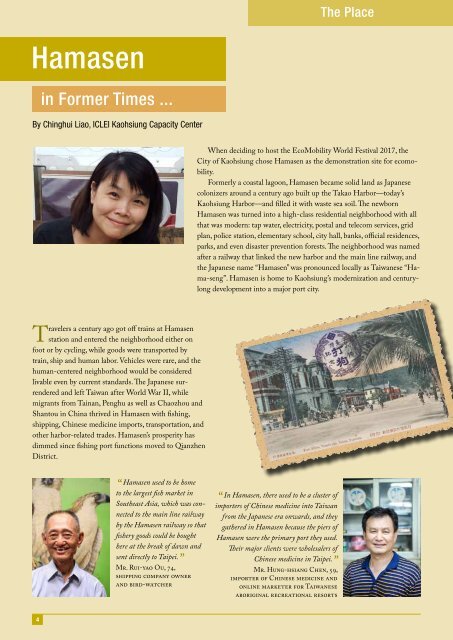Going Green – Experiencing the Ecomobile Lifestyle
ISBN 978-3-86859-512-3 https://www.jovis.de/de/buecher/product/going_green_experiencing_the_ecomobile_lifestyle.html
ISBN 978-3-86859-512-3
https://www.jovis.de/de/buecher/product/going_green_experiencing_the_ecomobile_lifestyle.html
You also want an ePaper? Increase the reach of your titles
YUMPU automatically turns print PDFs into web optimized ePapers that Google loves.
The Place<br />
Hamasen<br />
in Former Times ...<br />
By Chinghui Liao, ICLEI Kaohsiung Capacity Center<br />
When deciding to host <strong>the</strong> EcoMobility World Festival 2017, <strong>the</strong><br />
City of Kaohsiung chose Hamasen as <strong>the</strong> demonstration site for ecomobility.<br />
Formerly a coastal lagoon, Hamasen became solid land as Japanese<br />
colonizers around a century ago built up <strong>the</strong> Takao Harbor—today’s<br />
Kaohsiung Harbor—and filled it with waste sea soil. The newborn<br />
Hamasen was turned into a high-class residential neighborhood with all<br />
that was modern: tap water, electricity, postal and telecom services, grid<br />
plan, police station, elementary school, city hall, banks, official residences,<br />
parks, and even disaster prevention forests. The neighborhood was named<br />
after a railway that linked <strong>the</strong> new harbor and <strong>the</strong> main line railway, and<br />
<strong>the</strong> Japanese name “Hamasen” was pronounced locally as Taiwanese “Hama-seng”.<br />
Hamasen is home to Kaohsiung’s modernization and centurylong<br />
development into a major port city.<br />
Travelers a century ago got off trains at Hamasen<br />
station and entered <strong>the</strong> neighborhood ei<strong>the</strong>r on<br />
foot or by cycling, while goods were transported by<br />
train, ship and human labor. Vehicles were rare, and <strong>the</strong><br />
human-centered neighborhood would be considered<br />
livable even by current standards. The Japanese surrendered<br />
and left Taiwan after World War II, while<br />
migrants from Tainan, Penghu as well as Chaozhou and<br />
Shantou in China thrived in Hamasen with fishing,<br />
shipping, Chinese medicine imports, transportation, and<br />
o<strong>the</strong>r harbor-related trades. Hamasen’s prosperity has<br />
dimmed since fishing port functions moved to Qianzhen<br />
District.<br />
“<br />
Hamasen used to be home<br />
to <strong>the</strong> largest fish market in<br />
Sou<strong>the</strong>ast Asia, which was connected<br />
to <strong>the</strong> main line railway<br />
by <strong>the</strong> Hamasen railway so that<br />
fishery goods could be bought<br />
here at <strong>the</strong> break of dawn and<br />
sent directly to Taipei.<br />
”<br />
Mr. Rui-yao Ou, 74,<br />
shipping company owner<br />
and bird-watcher<br />
“<br />
In Hamasen, <strong>the</strong>re used to be a cluster of<br />
importers of Chinese medicine into Taiwan<br />
from <strong>the</strong> Japanese era onwards, and <strong>the</strong>y<br />
ga<strong>the</strong>red in Hamasen because <strong>the</strong> piers of<br />
Hamasen were <strong>the</strong> primary port <strong>the</strong>y used.<br />
Their major clients were wholesalers of<br />
Chinese medicine in Taipei.<br />
”<br />
Mr. Hung-hsiang Chen, 59,<br />
importer of Chinese medicine and<br />
online marketer for Taiwanese<br />
aboriginal recreational resorts<br />
4


















